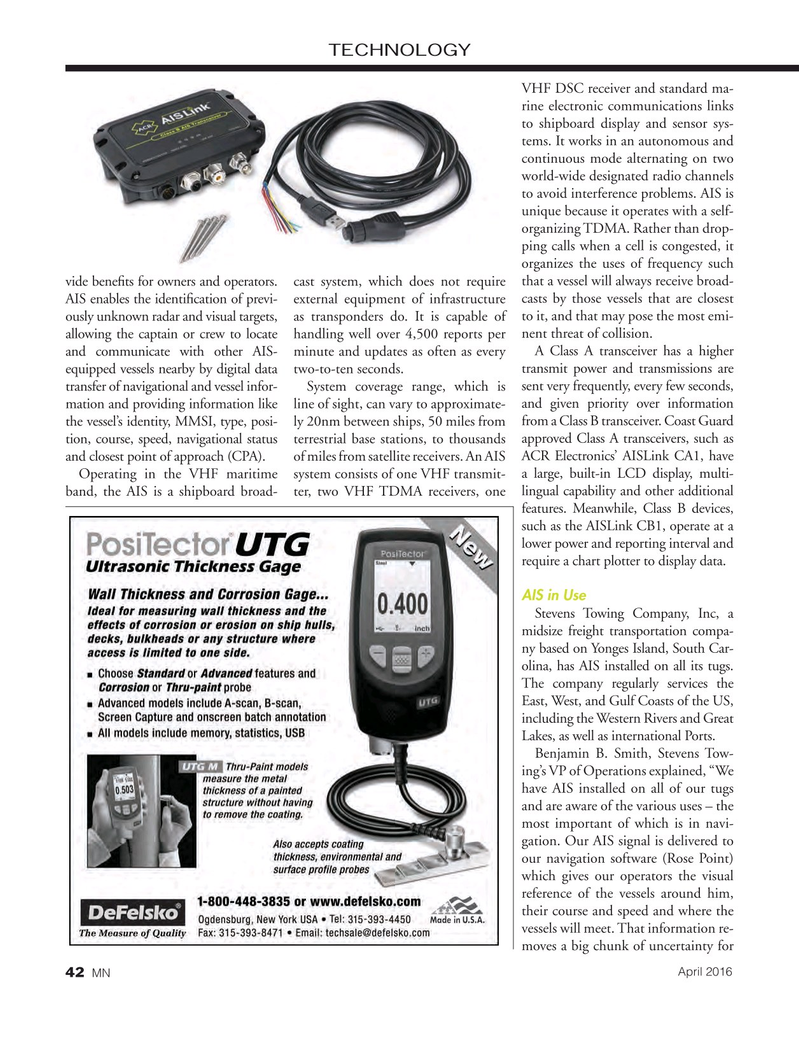
Page 42: of Marine News Magazine (April 2016)
Boatbuilding: Construction & Repair
Read this page in Pdf, Flash or Html5 edition of April 2016 Marine News Magazine
TECHNOLOGY
VHF DSC receiver and standard ma- rine electronic communications links to shipboard display and sensor sys- tems. It works in an autonomous and continuous mode alternating on two world-wide designated radio channels to avoid interference problems. AIS is unique because it operates with a self- organizing TDMA. Rather than drop- ping calls when a cell is congested, it organizes the uses of frequency such vide bene? ts for owners and operators. cast system, which does not require that a vessel will always receive broad-
AIS enables the identi? cation of previ- external equipment of infrastructure casts by those vessels that are closest ously unknown radar and visual targets, as transponders do. It is capable of to it, and that may pose the most emi- allowing the captain or crew to locate handling well over 4,500 reports per nent threat of collision.
and communicate with other AIS- minute and updates as often as every A Class A transceiver has a higher equipped vessels nearby by digital data two-to-ten seconds. transmit power and transmissions are transfer of navigational and vessel infor- System coverage range, which is sent very frequently, every few seconds, mation and providing information like line of sight, can vary to approximate- and given priority over information the vessel’s identity, MMSI, type, posi- ly 20nm between ships, 50 miles from from a Class B transceiver. Coast Guard tion, course, speed, navigational status terrestrial base stations, to thousands approved Class A transceivers, such as and closest point of approach (CPA). of miles from satellite receivers. An AIS ACR Electronics’ AISLink CA1, have
Operating in the VHF maritime system consists of one VHF transmit- a large, built-in LCD display, multi- band, the AIS is a shipboard broad- ter, two VHF TDMA receivers, one lingual capability and other additional features. Meanwhile, Class B devices, such as the AISLink CB1, operate at a lower power and reporting interval and require a chart plotter to display data.
AIS in Use
Stevens Towing Company, Inc, a midsize freight transportation compa- ny based on Yonges Island, South Car- olina, has AIS installed on all its tugs.
The company regularly services the
East, West, and Gulf Coasts of the US, including the Western Rivers and Great
Lakes, as well as international Ports.
Benjamin B. Smith, Stevens Tow- ing’s VP of Operations explained, “We have AIS installed on all of our tugs and are aware of the various uses – the most important of which is in navi- gation. Our AIS signal is delivered to our navigation software (Rose Point) which gives our operators the visual reference of the vessels around him, their course and speed and where the vessels will meet. That information re- moves a big chunk of uncertainty for
April 2016 42 MN
MN April16 Layout 32-49.indd 42 3/18/2016 10:38:03 AM

 41
41

 43
43
